I stood there and stared at it, there it was, just as I had visualized. It looked brilliantly gorgeous in the subdued evening light. “Love is the bridge between you and everything”, I muttered. Rumi has indeed captured my imagination and seems to have followed me even to this remote village in Meghalaya. The tantalizing double root bridge seemed like an entwined poetry between the two trees that flanked the Umshiang River silently flowing through the rounded stones that lie below. It was winter, and the reduced water level in the river made it look more like a stream.
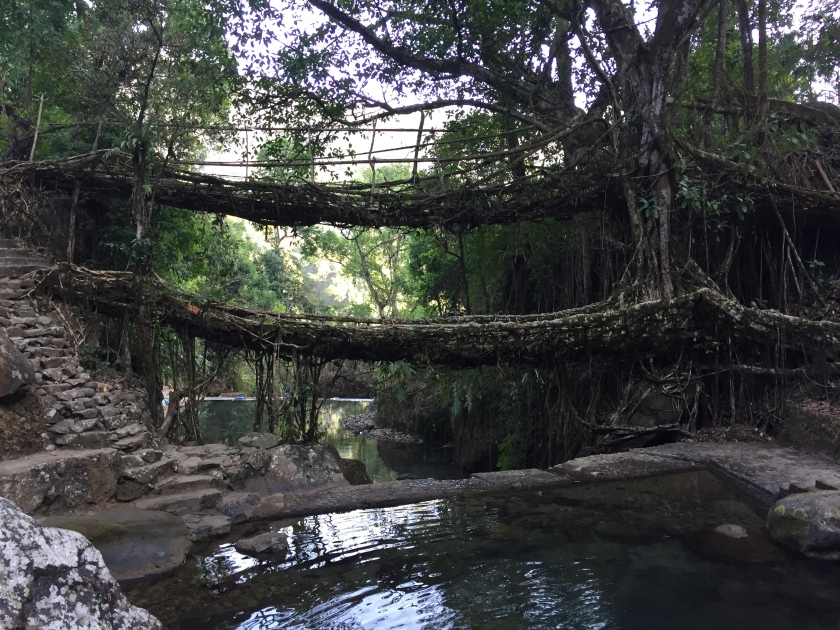
It was my first time at Nongriat village after braving 3600 steps and it was all worth it. The natural bridge floored me with its splendid elegance and grace. I couldn’t stop marveling at the ingenious organic engineering of the local tribal people. There are several root bridges in Meghalaya that are hand-crafted, using natural resources by the Khasi and the Jaintia tribes of Meghalaya (Khasis, Jaintias, Garos are the three tribes that constitute the native people of Meghalaya.).
These root bridges are made by guiding the aerial roots of Rubber tree (Ficus elastica) across a stream or river, and then allowing the roots to grow and strengthen over time. The young roots are tied, twisted, and weaved together encouraging them to combine with one another. The roots are wound around areca nut tree trunks, placed on either side of the water body. The roots keep growing, entwining the trunk and the bridge is elongated to the desired destination taking about 10-15 years to completion. The roots thicken over time and the bridge is further strengthened with mud, stones, sticks, and bamboos. These bridges last for hundreds of years and can carry the weight of 500 people at one time.
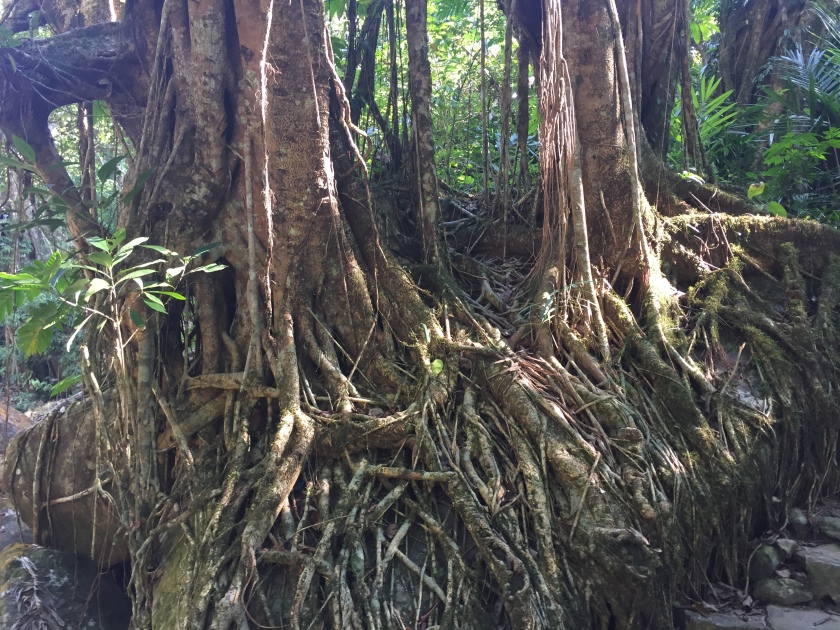
A UNESCO World Heritage Site, the double root bridge is nearly 200 years old. Locally known as Jingkieng Nongriat, the bridge is one of a kind and famous across the world. As a non-tribal resident of the state of Meghalaya, I could feel my chest swelling with pride as I stood there trying to fathom this tangled masterpiece hand-crafted by my tribal brethren.
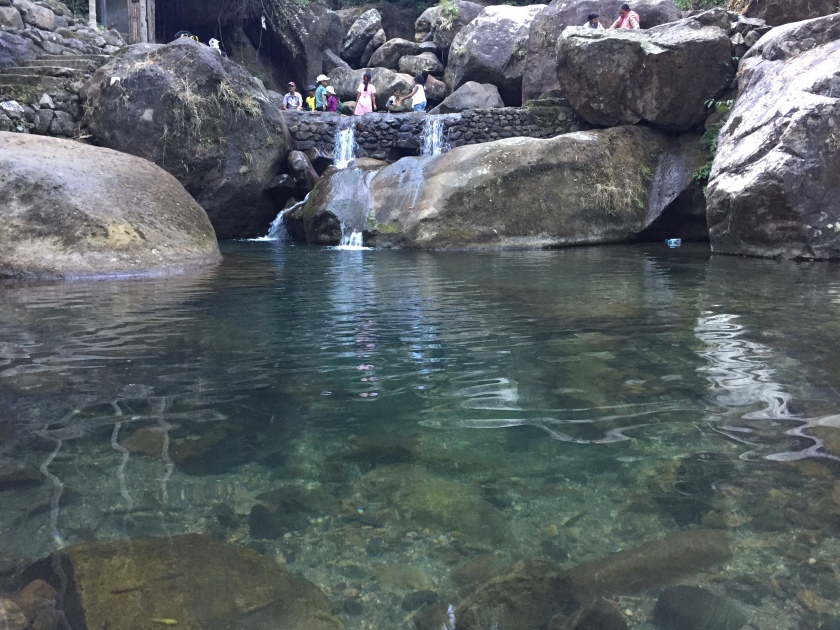
Soon, I found myself kicking off my walking shoes and settling down with my feet dipped in the cold water and the bridge right in front of me. My sisters joined in. We chatted into the evening accompanied by the occasional fishes that swam across tickling our tired and aching feet. We stayed at Nongriat and hence could enjoy the bridge in the way we wanted to, which would not have happened otherwise.
The reason being, it was the Christmas – New Year time, when the maximum surge of tourists happen leading to the place getting over crowded. To top it all, not all tourists who come here are nature lovers. It may seem strange but it is true. When we reached this place in the late afternoon that day, we were shocked to find people all over the place. There were some who were bathing in the river and shouting their lungs out disturbing the tranquil and serene surroundings. This is not how I had visualized the double root bridge and this is not my idea of enjoying nature. Dismayed, we walked away towards the jungle and came back only in the evening.
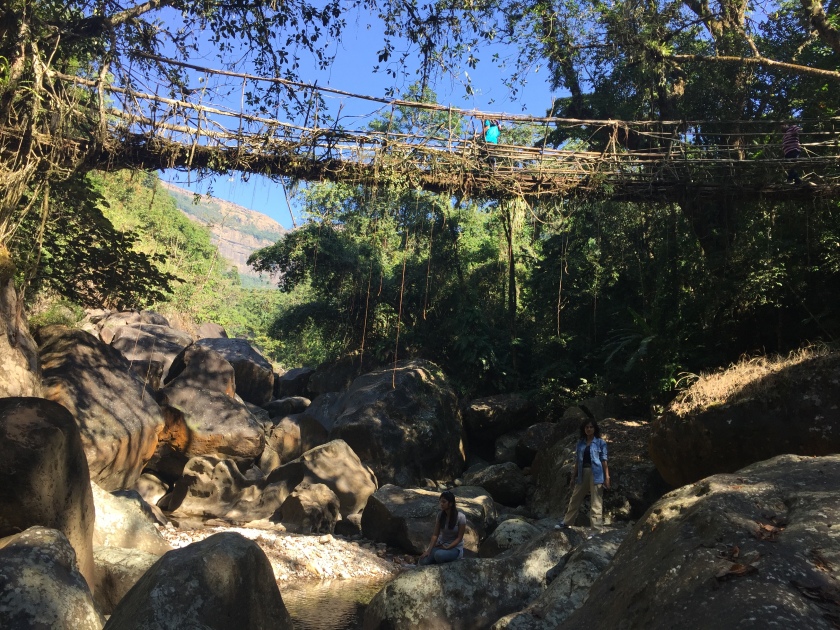
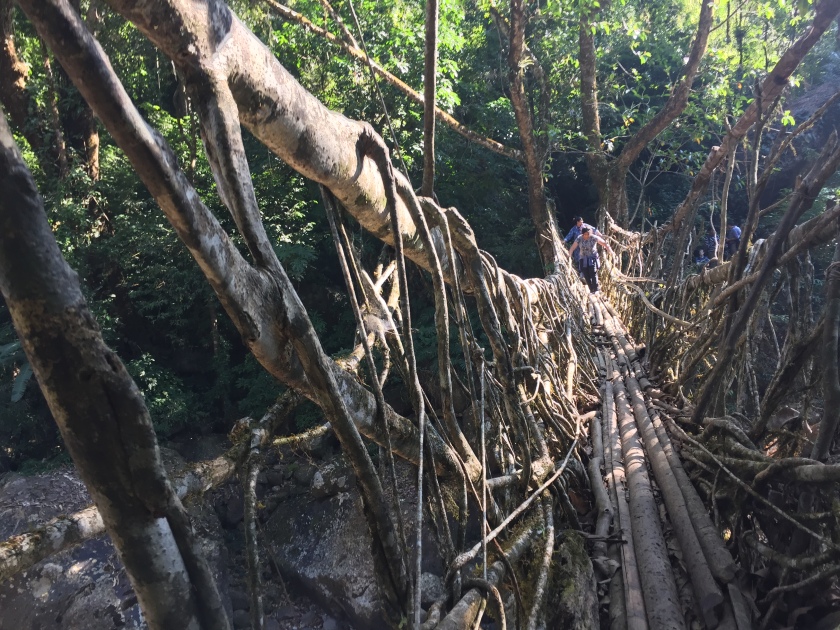
Earlier that day, while on our way to Nongriat, we had been to a single root bridge. It had a prominent notice displayed stating that only two people are allowed on the bridge at one time. But the crowd of over enthusiastic tourists had no time read that. We pointed out to many but they didn’t care. We waited for a very long time for the crowd to thin down before we embarked upon the bridge. The next day, we crossed two other bridges in the interiors of the village. Each one leaving us spellbound with their spectacular intricacies.
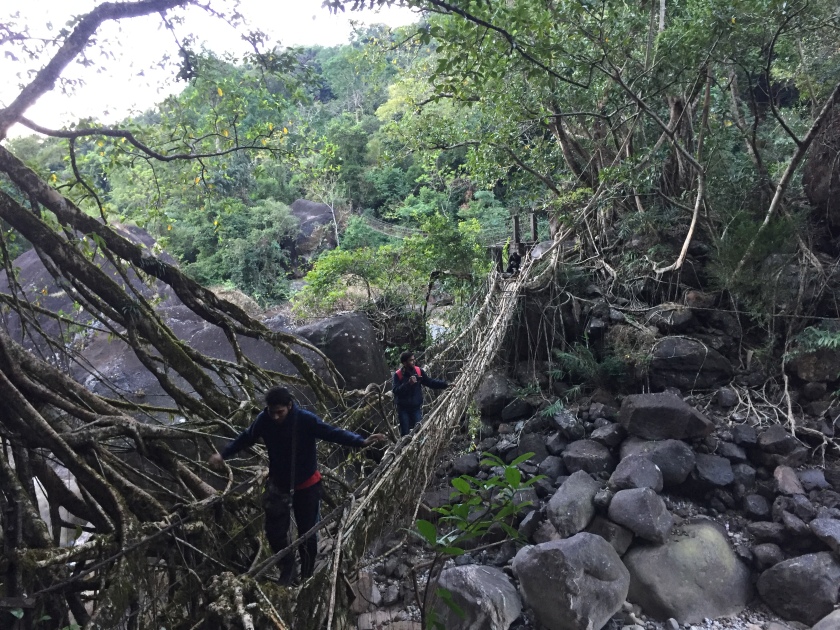
Last year when I was home, we had visited the single root bridge at Mawlynlong. That one is accessible by road and hence remains very crowded. However, the day we visited there was no one. We were really lucky. Mother Nature ensured peace so that we could soak in her comforting ecstasy.


Such complex structures. Really ingenious effort by the natives. Thanks for the names of the places. Would love to visit them. 👌
LikeLiked by 1 person
Yes, amazing coexistence with nature. You don’t need this blog to know the names of the places. Whenever you decide, just give me a call 🙂
LikeLiked by 1 person
Lovely article and cool photos! 😃
LikeLiked by 1 person
Thank you for reading, Marit 🙂
LikeLike
I have seen so many travelers picture of these living roots, I wish I could visit!
LikeLiked by 1 person
Arv, why wish….you must visit 🙂
LikeLiked by 1 person
That’s a million dollar question! I wish I could travel 😑😟
LikeLike
Hmm…..not sure if I should be asking…but any challenges?
LikeLiked by 1 person
Why not? …these are personal challenges and situations. Thanks for being concerned, Neel. Appreciate your sensitivity.
LikeLiked by 1 person
Thank you, Arv. Glad you did not mind. I hope your situation changes and you are able to go wherever you wish to.
LikeLiked by 1 person
Thank you so much for the good wishes, Neel. 🙂 I hope so… too!
LikeLike
This place is in my bucket list…hope to visit some day.
Great post Neel
LikeLiked by 1 person
Whenever you go Balaka, let me know. Will help you plan 🙂
LikeLiked by 1 person
Sure…you never know maybe this May..is May a good time to visit?
LikeLiked by 1 person
May is good time.
LikeLiked by 1 person
ok..inbox me your phone number and i will ask you the details
LikeLiked by 1 person
just brilliant…..as the prompt prompts….
LikeLiked by 1 person
Thank you so much! Glad you liked it.
LikeLiked by 1 person
Lovely post about trekking. My favorite thing. Will bookmark this post for future.
LikeLike
Thank you Megha 🙂
LikeLiked by 1 person
My pleasure
LikeLike
Wow! Awesome bridge. I’ve never heard of them before so it was pretty amazing to learn about them.
LikeLiked by 1 person
These living bridges are a wonder! Truely amazing ❤
LikeLiked by 1 person
Nice place😊
LikeLiked by 1 person
Thank you for reading 😊
LikeLike
You are welcome😊
LikeLiked by 1 person
I’ve only been to the single root bridge near Mawlynnong. That was a wonderful experience for me, as I was encountering such a natural bridge for the first time. I don’t think there are any other states where such structures exist, in this manner. But of course, it was a bit crowded.
Since you stayed back at Nogriat, you could experience the bridges in all their glory, and amidst peace and quiet – something not many do, since it’s popular as just a day trek – and so not just the famous one, but three more. So that’s a good option to consider for anybody visiting the double-decker root bridge (and I’d surely consider). And letting fishes nibble at your feet… that sounds exciting as well!
I think being able to visit these root bridges are an experience of a lifetime. Glad I could visit at least one till now.
LikeLiked by 1 person
The double root bridge is much more raw and rustic than the one at Mawlynlong. It’s a must visit, You must absolutely plan provided you’re ready to brave the stairs 😀…….and it’s not just the bridge, the entire 3.5 km hike is awesome, will write about that soon. And do stay at Nongriat, it’s v beautiful. I would have liked to stay another day but competing priorities!
LikeLiked by 1 person
👍👍😊😊
LikeLike
I’m planning to go back to the Nongriat bridge this December vacation. But now that I read your post again, I think it will not be the same as the previous time.
LikeLike
If you go in December, it might be crowded, especially during the Christmas time. And, with all the popularity of these places the footfall in Shillong and adjoining areas have quadrupled in the last 1-2 years so your experience will be impacted surely.
LikeLike
Amazed to know about the making of root bridges and its life ! Very nicely written !
LikeLiked by 1 person
Thank you so much for reading this. This post is one close to my heart 🙂
LikeLike
Beautiful write! I have visited mawlynlong village as well.
LikeLiked by 1 person
Yes, heard that’s terribly crowded now. 😦
If such kind of rush is not controlled , the bridges will give way soon!
LikeLiked by 1 person
I thoroughly enjoyed reading your version of the story. I too found Meghalaya to be crowded with tourists wherever we went. Guess Christmas – New year isn’t a great time to be travelling to this place.
LikeLiked by 1 person
These are the usual tourist places that remain crowded. However, there are tonnes of places that are still tranquil and quiet. And, I seriously hope they remain that way.
LikeLike